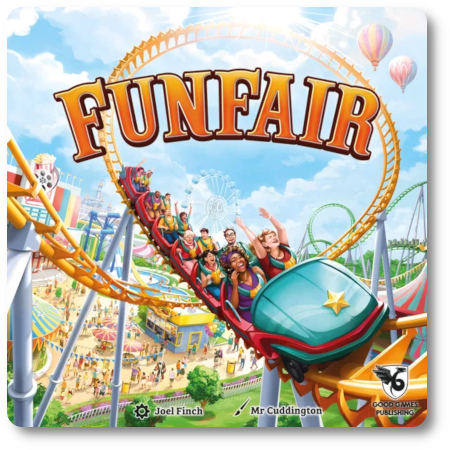
The Basics:
- For ages 10 and up (publisher suggests 14+)
- For 2 to 4 players
- Approximately 45 minutes to complete
Geek Skills:
- Counting & Math
- Logical & Critical Decision Making
- Reading
- Strategy & Tactics
- Risk vs. Reward
- Hand/Resource Management
Learning Curve:
- Child – Easy
- Adult – Easy
Theme & Narrative:
- Build the funfair park of your dreams!
Endorsements:
- Gamer Geek approved!
- Parent Geek approved!
- Child Geek approved!
Overview
The well-known researcher who focuses on why people make choices, Sheena Iyengar, said, “It’s always a thrilling experience to go into a place that offers you a lot of choice. You know it’s like it reminds you of when you’re a kid, and you go to the amusement park and whether it be Disneyworld or Six Flags you know that thrilling moments are there when you first enter, and you know you’ve got all these possibilities for the day and it’s really a wonderful feeling.” In this game, players can build any park they like with the rides they always wanted to have. Let your imagination be your guide as you create the greatest funfair in the world!
Funfair, designed by Joel Finch and published by Good Games Publishing, is comprised of 97 Park cards, 20 Blueprint cards, four Showcase cards, 12 City cards, four Gate cards, five Awards cards, one Closure card, one game board, 78 Coin tokens (in various number values), one Starting Player maker, one Step Tracker miniature, four Reference cards, and a score pad with an accompanying pencil (which is a nice touch). The cards are as thick and as durable as your standard playing card. The game board, Starting Player marker, and tokens are made of thick cardboard. The Step Tracker is a plastic miniature of two people in a roller coaster car who are most likely only seconds away from puking. All in all, great quality which is further improved by the excellent illustrations by artists Lina Cossette, Joel Finch, and David Forest who provide colorful images of the people, the rides, and the funfair fanfare. You can almost smell the popcorn…
Let’s Build a Park!
To set up the game, first place the game board in the middle of the playing area. It has two sides. One side is great if you are playing with only two people and both you and your opponent are on one side of the table. The other side works great if you are playing with an opponent sitting opposite and on either side of you. Neither of the sides changes the gameplay.
Second, place the Step Marker miniature on the City space on the step tracker found on the game board. Give each player a Gate card and a random Showcase card. The Gate card should be played face-up in front of the owning player, with the Showcase card placed above it and face-down. Players may look at their own Showcase card but should keep it secret until played. At this time, give each player a Reference card, as well, and a total value of 30 Coin tokens. Place all remaining Coin tokens in their own pools and within each reach of all the players.
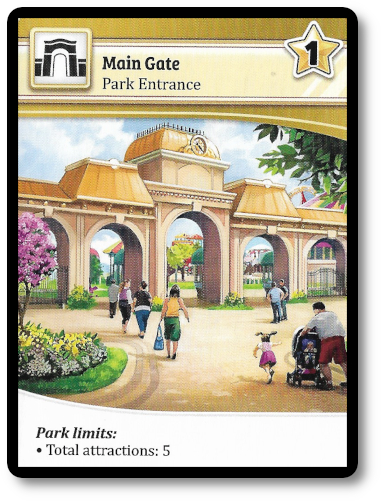
Third, shuffle the Park cards and deal five to each player. This is the player’s starting hand. Players should look at their cards but keep them secret until played. If the player doesn’t have at least one “attraction,” they discard their hand and get a new one. Place the remaining Park cards face-down on their designated game board space, shuffling any discarded Park cards back into the deck. Shuffle the Blueprint cards now, as well, placing them in their designated game board spot.
Fourth, shuffle the City cards and deal two face-down to its designated game board space. Then place the Closure card on top of these two cards with the “Closing Soon” side facing up. Follow this by dealing an additional four City cards on top of the Closure card, face-down. All remaining City cards are returned to the game box.
Fifth, shuffle the Award cards and place them face-down on their designated game board spot. Once completed, draw and flip over the first Award card for all to see.
Sixth, deal from the Park draw deck on the game board six Park cards, placing them face-up on the game board. This row of Park cards is referred to as the “Market”.
That’s it for a game setup. Determine who will go first and pass them the Starting Player marker. Time to have some fun at the fair!
Building Amusement Dreams Into Economic Reality
Funfair is played in rounds and turns, with a total of six rounds per game. A single game round is summarized here, which comprises four specific steps with unique actions for the players to take. It is should also be noted that some cards have their own unique actions which should be played at the time the card suggests.
Step One: The City
The first step focuses on the thematic city where the player’s funfair is located. The current round’s starting player draws the top-most City card and reads it out loud to the table. Each player now follows the instructions provided by the card, resolving the action note if possible. Resolution is made in turn order sequence. Some City cards are only resolved and active during certain steps.
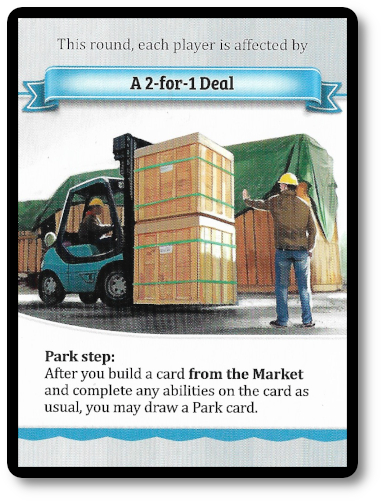
The City cards also keep track of the number of rounds left in the game. The Closure card will come into play on the fourth round, reminding players that their time to draw a Blueprint card is getting short.
City cards remaining face-up in their discard pile and “active” for the duration of the round. The Closure card is the one exception. It’s placed on top of the Blueprint draw deck, officially “closing” that draw deck to the players.
Step Two: The Park
The second step is also resolved in turn order sequence. On the player’s turn in the step, they have four actions they can select from. Each player will have three turns, at a minimum in this step with a possible fourth turn, but only if they have built their Showcase. When it’s again the starting player’s turn in the turn order sequence, the Step Tracker miniature is moved on the game board to help keep track of the number of turns available in the round.
The available actions are noted here. Again, some cards the player might have in play could provide additional actions.
Build Your Park
This step allows the player to build any one Park card from their hand or face-up on the game board. If the player takes from the game board, they must build that card. The drawn card is immediately replaced from the Park draw deck.
Each card’s cost is listed, which is paid for by the player using their Coin tokens. When building, a few rules apply.
- A player may not have any more than five Park cards with the keyword “Attraction.” This includes the player’s Showcase card. To help keep track of the total number of attractions the player has built, these cards are placed face-up and in a row to the right of the player’s Gate card.
- A player may not have two or more attractions with the same name. It would be pretty boring if your park had five of the same ride, right?
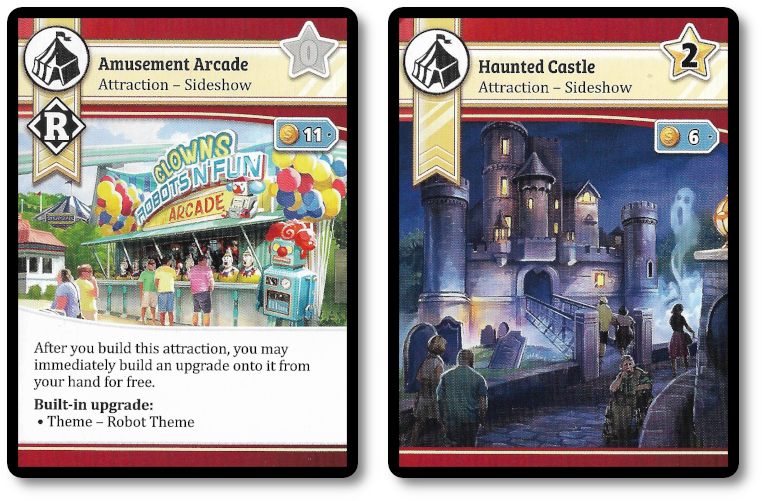
Both are “attractions”, but one is named “Amusement Arcade” and the other is named “Haunted Castle”
- “Staff Member” Park cards are built to the left of the player’s Gate card. There is no limit to the number of Staff Members the player can have in play, but you cannot have two or more Staff Members with the same name (same rules as attractions).
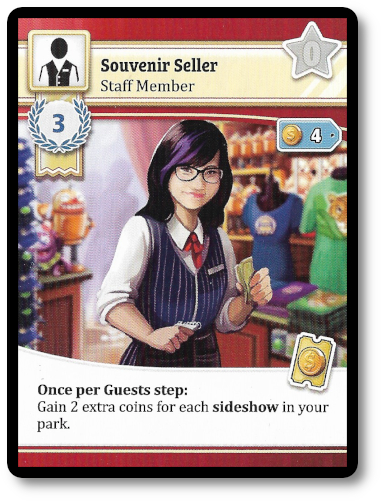
- Upgrades are placed behind the attraction they are improving, creating a column. You cannot have two or more upgrades with the same name.
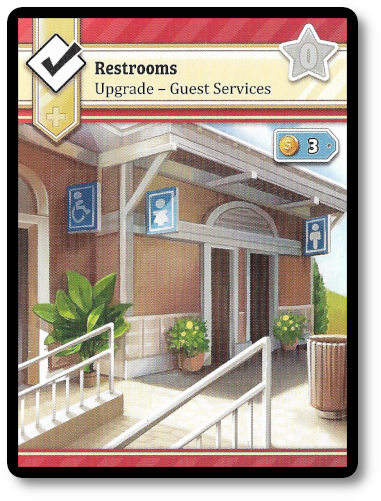
Players can take this action to build their Showcase card, as well. Showcases represent the “super attraction” that is the signature and most popular ride the player’s park offers. As the game progresses, “investors” will be adding Coins to the top of the unbuilt Showcase. The player can only use these Coins to pay for and offset the Showcase card’s total cost. These Coins come with the hitch that you have to “use them or lose them,” so spend them when you can to help build your Showcase!
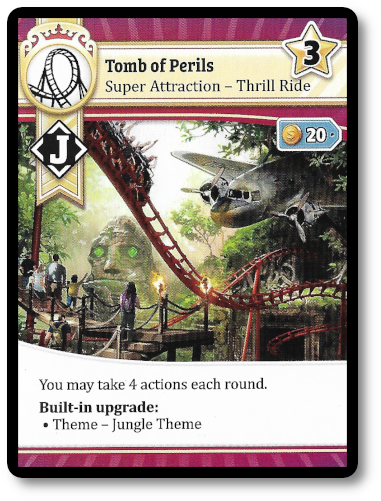
Take Cards
The player has three options for this action.
The player can take any face-up Park card in the Market, adding it to their hand, and immediately refilling the open space by drawing a new card.
If the player needs that “special something-something,” they can discard one Park card from their hand and draw five from the draw deck. From these five, they keep one and discard the rest.
Finally, the player can elect to draw two Blueprint cards and can choose to keep one, discarding the other. Blueprint cards will award the player extra points at the end of the game if they complete the requirements. However, failure to do so will cost the player points at the end of the game. Blueprints also come with bonus points awarded at the end of the game but do not penalize the player if the condition for the bonus isn’t met. There is no limit to the number of Blueprints a player can have in their hand, but a player cannot get rid of them once they have them. Therefore, caution is needed to ensure the player doesn’t over-promise to their investors but fails to deliver at the end of the game. A player is never forced to take a Blueprint card, but once they do, they own it for the duration of the game. Each Blueprint card comes with a difficulty rating, making a choice a bit easier for the squirmish.
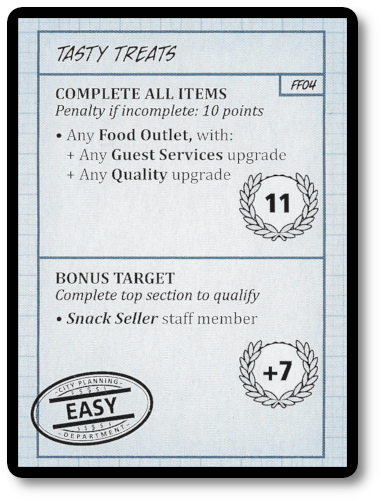
Find Loose Change
This action allows the player to collect a Coin value of “one” for each Attraction they have in play. Thematically speaking, these coins are the ones that fell out of the player’s customer’s pockets.
Demolish
This action allows the player to discard any currently built cards. A player can decide to demolish an upgrade or an entire attraction. If the player elects to demolish an attraction, all attached upgrades are discarded, too. The same goes for the Showcase, but the Showcase card is removed from the game. Players do not get any money back from what they invested in. This action only gives the player space to correct a previous round’s action.
Step Three: Collect Your Money from Guests
All players now add up the star icon’s number values on the cards they have built into their park. The total number is the number value of Coins they now collect. Some Staff Members will award additional Coins during this step.
During this step, each player is given a Coin with a value of “five” placed on their unbuilt Showcase card. Again, the player can only use these Coins to offset the total cost of the Showcase. Since a Showcase costs 20 Coins, the player can build the Showcase for free during the fifth round of the game.
Step Four: Clean Your Park
The final step is all about maintaining the game.
- Discard all Park cards in the Market area on the game board and refill.
- All players must discard down to no more than five Park cards in their hand. Blueprint and Showcase cards do not count towards the player’s hand size limit.
Lastly, check to see if there are still City cards to play. If City cards still remain, start the next round by moving the Step Tracker back to its starting position and passing the Starting Player marker to the next player in the turn order sequence.
Closing Time
The game ends after the sixth round is completed. All players now determine their final score using their Reference card and recording the number values on the provided score pad. Player’s earn points based on their attraction size, completing the requirements listed on Blueprint cards, the number of Coins they haven’t spent (not counting those on the Showcase card), and from their Staff Members. Keep in mind that players can lose points for any Blueprint card they did not complete.
Also, all players can add to their score the Awards bonus if they meet the requirements listed on the Award card.
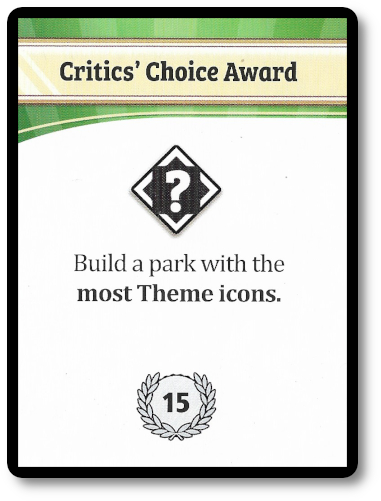
The player with the most points wins the game!
To learn more about Funfair, visit the game’s webpage.
Final Word
 All but our youngest Child Geeks (who were younger than the recommended minimum age noted by the publisher) loved the game. Funfair is not a complicated game to learn, but it challenges the player to build their park carefully. This can feel a bit overwhelming at first because there are many options available. According to one Child Geek, “I liked the game a lot after I played it the first time. When I first learned, I didn’t think it sounded hard, but you have so many cards you can play. I didn’t know what I should play and that made me nervous. But I still liked the game a lot.” Another Child Geek said, “I liked that we were all in competition with each other, but we left each other alone to build the park of our dreams. I cannot wait to go to the parks and ride on the rides again!” So true. When the Child Geeks built all the parks, the Child Geeks surveyed their creations and gave the game their full approval.
All but our youngest Child Geeks (who were younger than the recommended minimum age noted by the publisher) loved the game. Funfair is not a complicated game to learn, but it challenges the player to build their park carefully. This can feel a bit overwhelming at first because there are many options available. According to one Child Geek, “I liked the game a lot after I played it the first time. When I first learned, I didn’t think it sounded hard, but you have so many cards you can play. I didn’t know what I should play and that made me nervous. But I still liked the game a lot.” Another Child Geek said, “I liked that we were all in competition with each other, but we left each other alone to build the park of our dreams. I cannot wait to go to the parks and ride on the rides again!” So true. When the Child Geeks built all the parks, the Child Geeks surveyed their creations and gave the game their full approval.
 The Parent Geeks also found the game to be entertaining. According to one Parent Geek, “I found the game to be engaging and relaxing. It has an excellent pace that let me focus on building what I wanted, and I didn’t even really care that much about what others were building. Yes, I lost a lot, but I had a lot of fun doing it, so I guess I also win?” Sure. Another Parent Geek said, “A fun game about building your park and the economic engine that it can become. I loved the cards and the gameplay. I would play this again and again. Easy to get to the table and even easier to enjoy.” When all the parks were closed, the Parent Geeks gave the game their full approval.
The Parent Geeks also found the game to be entertaining. According to one Parent Geek, “I found the game to be engaging and relaxing. It has an excellent pace that let me focus on building what I wanted, and I didn’t even really care that much about what others were building. Yes, I lost a lot, but I had a lot of fun doing it, so I guess I also win?” Sure. Another Parent Geek said, “A fun game about building your park and the economic engine that it can become. I loved the cards and the gameplay. I would play this again and again. Easy to get to the table and even easier to enjoy.” When all the parks were closed, the Parent Geeks gave the game their full approval.
 The Gamer Geeks found Funfair to be tight and well thought out. None of them complained or had any issue with how the gameplay evolved in front of them or how they scored. In fact, the only thing they did complain about is that the game felt a bit too relaxed at times. According to one Gamer Geek, “The game is so relaxing and focuses fully on the player that you forget you are competing with others. If you want to stay competitive, you need to keep track of everyone’s parks. I wish there were a mid-game scoring rule in play to determine who I needed to watch. But that’s it. I thought the game was good stuff.” Another Gamer Geek said, “I fully approve of this game. Light and casual, but deep and strategic. A great example of how we can make a game that requires thinking but make it an exercise in entertaining and careful thought.” When all the cheers were silenced, and the parks swept, the Gamer Geeks gave the game their full approval.
The Gamer Geeks found Funfair to be tight and well thought out. None of them complained or had any issue with how the gameplay evolved in front of them or how they scored. In fact, the only thing they did complain about is that the game felt a bit too relaxed at times. According to one Gamer Geek, “The game is so relaxing and focuses fully on the player that you forget you are competing with others. If you want to stay competitive, you need to keep track of everyone’s parks. I wish there were a mid-game scoring rule in play to determine who I needed to watch. But that’s it. I thought the game was good stuff.” Another Gamer Geek said, “I fully approve of this game. Light and casual, but deep and strategic. A great example of how we can make a game that requires thinking but make it an exercise in entertaining and careful thought.” When all the cheers were silenced, and the parks swept, the Gamer Geeks gave the game their full approval.
 Well, there you go, folks. Three out of three groups enjoyed and approved the game! And why not? The game is a perfect blend of strategy and tactics, deep enough to let you explore and find new ways to victory and light enough to make sure you never get lost in the proverbial weeds—a great example of a casual game that keeps you hooked from the start to the end.
Well, there you go, folks. Three out of three groups enjoyed and approved the game! And why not? The game is a perfect blend of strategy and tactics, deep enough to let you explore and find new ways to victory and light enough to make sure you never get lost in the proverbial weeds—a great example of a casual game that keeps you hooked from the start to the end.
What I like most about this game is how replayable it is and how my park unfolds in front of me with its crazy theme rides and various attractions. I found myself wanting to spend more time in my park, building out more attractions and entrances. I wanted to, in fact, be even more tactical with my builds and how the guests were approaching it, but that’s not the game. Funfair is all about the build and development, not the layout or flow of foot traffic. This is good because the game strikes a perfect balance that leaves you wanting more but always satisfied, too.
Do try Funfair when time permits. I think you’ll find it to be an enjoyable experience that will make you yearn for the days we can all return to the theme parks and get hassled by the carnies and barkers on the midway.
This game was given to Father Geek as a review copy. Father Geek was not paid, bribed, wined, dined, or threatened in vain hopes of influencing this review. Such is the statuesque and legendary integrity of Father Geek.



